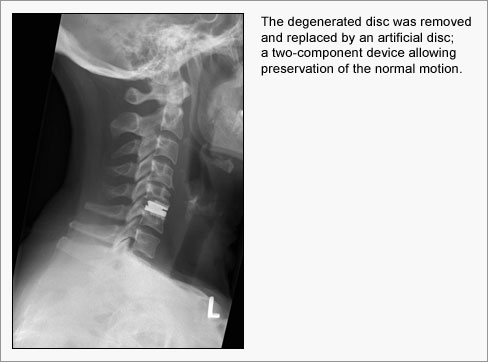
Cervical radiculopathy is an inflammation of the nerve in the cervical spine from the exit point which is called neuroforamen. most neck pain does go away after several weeks but there are some neck pain that can persist and may radiate to the arms and shoulders. Cervical radiculopathy symptoms may include weakness, numbness or pain in various areas of the hand and arm. Common conditions that are generally linked to cervical radiculopathy include:
Cervical Spondylosis
This condition is the continuing tear and wears changes due to advance age. this is often referred to as degenerative spine disease. most of this condition can be identified through the traditional X-rays and other imaging examinations. Conditions like calcification of disc, narrowing of disc space, bulging of the shape of the disc and bone spurs can be clearly seen in this imaging device.
Cervical Disc Herniation
The disc is located in between the vertebrae. this disc consist of two layers that is the outer layer which is tough and the inner layer which is made up of a gel like material. an injury to the outer layer may change the shape of the disc especially if the inner material is pushed out to the outer layer. this condition is called disc herniation. When this injured disc compressed a nerve then it can result to pain.
Diagnosis of Cervical Radiculopathy
Evaluation and Diagnosis of Cervical Radiculopathy always starts with a physical examination by the doctor. With a thorough and careful physical examination the condition may be detected along of course with the symptoms of the patient.
Also traditional X-rays and MRI will show the bony spur formation in the nerve foramen. CT scans and MRI can show soft tissue structures like the nerves, discs which cannot be seen in X rays thus most conditions can be accurately diagnose or identified in this scans. most important thing is these findings will be associated with the patient’s symptoms. Unfortunately there is a finding that a high rate of spondylosis and disc herniation occurs in individual who never experience any symptoms at all (J Bone Joint Surg Am. 1991)
Non-Surgical Treatment
There are several studies that support for the non-surgical treatment of cervical radiculopathy. there are studies that showed that cervical radiculopathy improves without resorting to surgery at all. In fact two studies showed that cervical radiculopathy has significantly improved using non-invasive form of treatment after repeated of scans ( Spine Journal, 2003). other studies showed significant improvement of cervical radiculopathy treated with non-surgical therapies like using anti-inflammatory, epidural steroid injections, physical therapy, oral corticosteroids and brace ( Eur.Spine J 1996, Spine, 1996)
Fortunately most patients recover from cervical radiculopathy using the non-surgical form of treatment although there are instances that pain still continues despite the traditional treatment. if this is the case then surgical treatment may be recommended